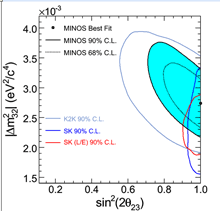 |
Monday, August 7, 2006 |
Sending a high-intensity beam of muon neutrinos from Fermilab to a neutrino detector in the Soudan Underground Laboratory in Minnesota, the MINOS collaboration observed the disappearance of about half of these neutrinos. The number of "disappeared" neutrinos is consistent with an effect known as neutrino oscillation: muon neutrinos can change into tau neutrinos or electron neutrinos, which can escape detection by the 6,000-ton MINOS far detector.
Without neutrino oscillation, the MINOS far detector would have recorded, after filtering the data, 336 +/- 14 muon neutrinos. Instead, the MINOS collaboration observed 215 muon neutrinos.
The existence of neutrino oscillations implies that neutrinos have mass. The MINOS collaboration can measure the mass difference between two of the neutrino states. Christopher Smith, the speaker at Friday's seminar, reported a value of delta m2 = 2.74 +0.44-0.26 x 10-3 eV2. Thus the difference in mass between the two neutrino states corresponds to an amount that is about ten millionth of the mass of an electron.
After only one year of data taking, the precision of the MINOS result of delta m2 is already competitive with earlier measurements made by the Japanese Super-Kamiokande and K2K experiments. At present, MINOS provides the best accelerator-based measurements for both delta m2 and the neutrino oscillation parameter known as sin2 theta (see graphic).
Compared to K2K, the MINOS experiment uses a three times longer distance (450 miles vs. 150 miles), and the intensity and the energy of the MINOS neutrino beam are higher than the K2K beam. This combination of beam parameters has led to a larger number of neutrinos observed by the MINOS collaboration, and it provides scientists with a better opportunity to measure the oscillation angle theta. In less than a year, the MINOS experiment has observed about three times more neutrinos than the K2K experiment did in about four years.
Over the next few years, MINOS will record almost 50 times more neutrinos than did K2K, which operated between 1999 and 2004. The larger amount of data will yield results with higher precision, paving the way to better understanding neutrino oscillations.
--Kurt Riesselmann
